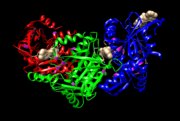Sandbox viralpackagingmotors
From Proteopedia
This page is setup for Ojuewa to build her senior project for OU CHEM 4923
Viral Packaging
|
One of the most important stage in the life cycle of all viruses is the encapsidation (packaging) of the viral genome. The viral genome packaging motor is a multicomponent molecular machine that must complete several task in sequential order, the foremost of which is the ATP-dependent pumping viral DNA into the procapsid. [1] Many viruses such as tailed dsDNA bacteriophages among others package their genome into empty capsids via a portal vertex complex. The packaging motor is generally multiple copies of a single protein, and an example is the P4 protein that uses the RNA packaging motor. The RNA packaging motor is powered by the hydrolysis of ATP.
Contents |
Function
The RNA packaging motor is a straightforward machinery that consists of a portal protein (P4) hexamer. It is the P4 protein that provides energy for RNA translocation.
Disease
The two methods of virion nucleic acid packaging known are (1) co-condensation of the nucleic acid with viral capsid proteins to form a virus particle ( employed by viruses such as HIV, TMV, AND M13 and (2) translocation of the nucleic acid into the a preformed procapsid shell ( found in eukaryotic viral families such as herpes and tailed dsDNA bacteriophages such T4, lambda and phi29, among others). [2]
Relevance
Structural highlights
This is a sample scene created with SAT to by Group, and another to make of the protein. You can make your own scenes on SAT starting from scratch or loading and editing one of these sample scenes.
</StructureSection>
References
- ↑ Mancini EJ, Kainov DE, Grimes JM, Tuma R, Bamford DH, Stuart DI. Atomic snapshots of an RNA packaging motor reveal conformational changes linking ATP hydrolysis to RNA translocation. Cell. 2004 Sep 17;118(6):743-55. PMID:15369673 doi:10.1016/j.cell.2004.09.007
- ↑ doi: https://dx.doi.org/10.1039/9781849732239-00203

